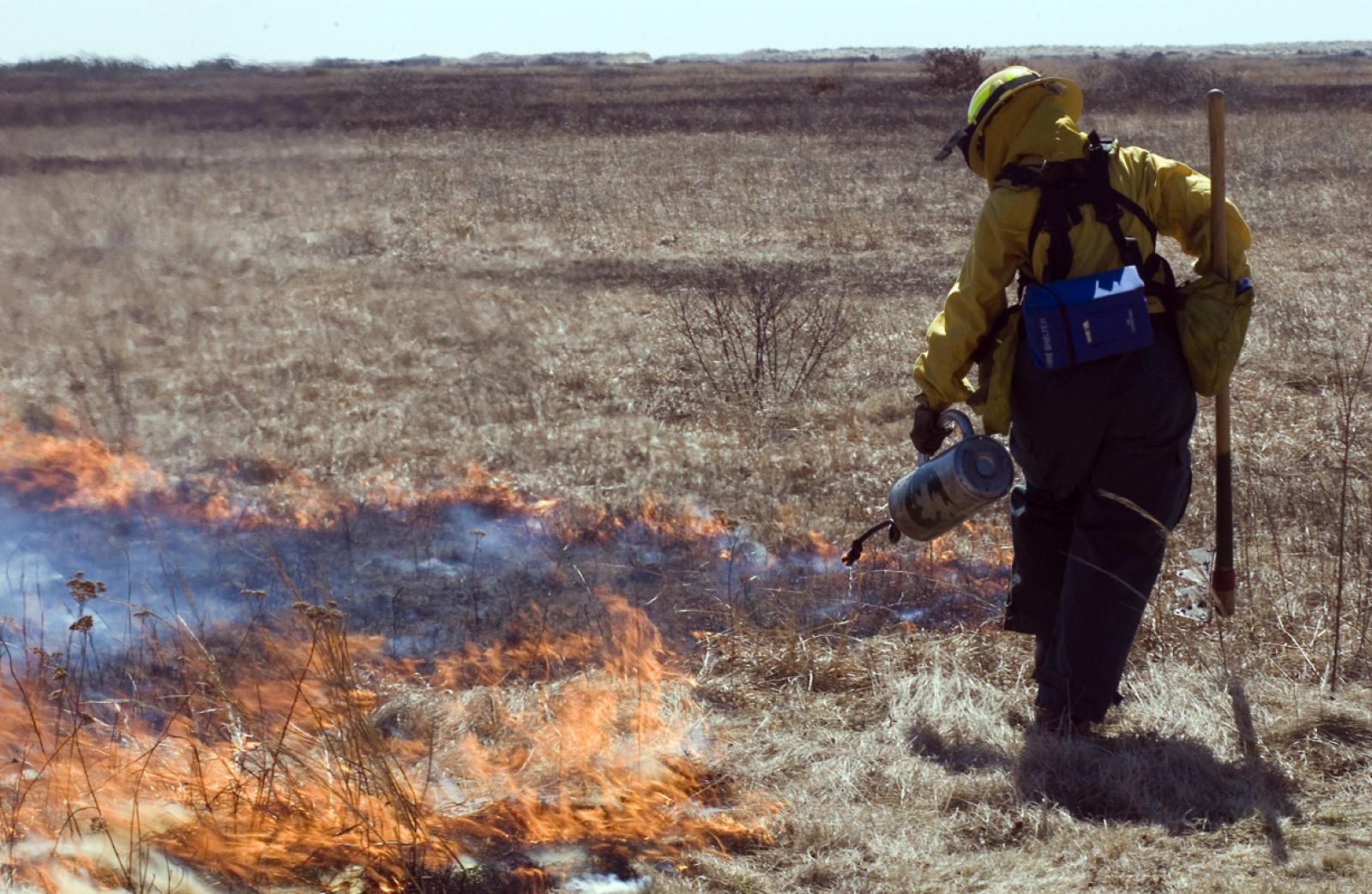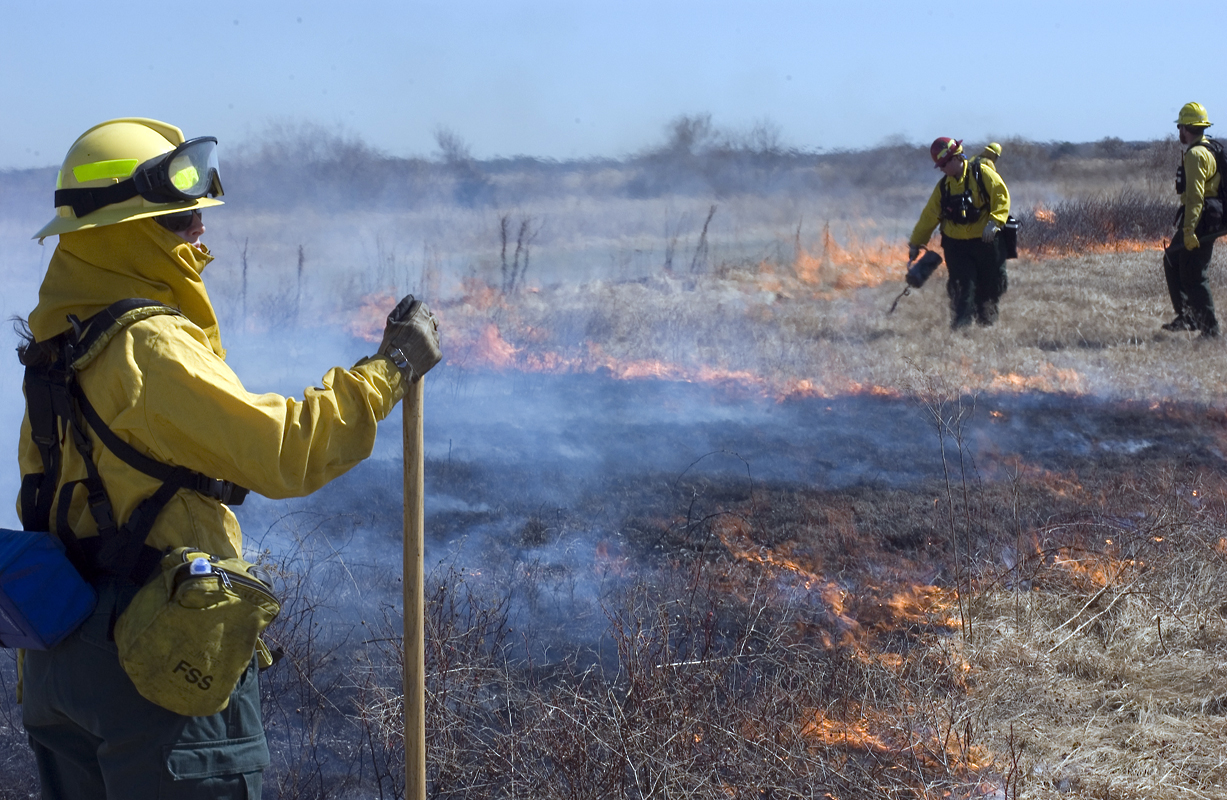“We all help each other burn each other’s property,” says Bob Bale, the Nature Conservancy’s Southeast Massachusetts chapter fire manager. It may sound like an insurance fraud pact among pyromaniacs, but Mr. Bale is describing the efforts of the Martha’s Vineyard Prescribed Fire Partnership, a group that includes the Nature Conservancy, Mass Audubon’s Felix Neck Wildlife Sanctuary, The Trustees of Reservations, the Polly Hill Arboretum and the Sheriff’s Meadow Foundation. Their aim is to protect the public from the threat of wildfire and preserve the unique fire-dependent ecology of the Island.
Until the spring starts putting leaves back on the trees, the dryness of the Vineyard’s naked vegetation poses a fire risk. And in a closed environment like an island, that risk requires vigilant management. That’s why Mr. Bale’s burn teams as well as groups from the Massachusetts Department of Conservation and Recreation (DCR) are`` fanning out across the Vineyard, starting fires to stop fires.
Yesterday the Martha’s Vineyard Prescribed Fire Partnership kicked off the season with a controlled burn at the Katama Airport. On Saturday the DCR will be holding a public meeting at the Manuel F. Correllus State Forest headquarters off of Barnes Road at 1 p.m. to discuss their plans to prevent wildfires in the forest, using both burns as well as mowing techniques. The meeting will be followed at 2 p.m. with a site visit to view the planned treatment areas.
“Some of these areas that we’re burning haven’t seen fire in 40 to 50 years,” said Dukes County forest fire patrolman Aaron Whiddon in an interview, “and the fuel loading, which is the amount of flammable vegetation in these particular areas, is tremendous. It poses a significant fire hazard not only to the firefighters such as myself but also to the public.”
Mr. Whiddon says that areas in the state forest have been targeted for burns both upon the likelihood of combustion as well as proximity to residential areas.
“I can’t stress enough that the number one priority of these burns is public safety,” he said.
It may seem counterintuitive to fight fire with fire, but the key element to a prescribed burn is control.
“You’re much better off having a fire under terms that you dictate versus having a one under unpredictable conditions,” explains John Varkonda, supervisor of the Manuel F. Corellus State Forest.
Residents wary of the prospect of controlled fires need only consult the sensational record of uncontrolled wildfires that annually terrorized Vineyarders in the first half of the last century.
“There were days when basically the whole middle of the Island burned in one day,” said Mr. Bale. Indeed on May 12, 1916, wildfire consumed nearly 20 square miles of the Island. As the Gazette reported, “[It] started near West Tisbury and in about two hours was beating at the outskirts of Edgartown.”
It was that fire that is largely blamed for the extinction of the heath hen; however, such blazes were far from unusua l. In 1926, 10 square miles were lost to flame, followed by another 10 the following year and another four, these at Waldron’s Bottom, going up in 1929. The situation was so dire it led the editors of this newspaper to throw up their hands in a 1930 editorial and lament, “In the light of experience, there is nothing to look forward to but more fires, year after year, and a perpetually blasted plain.”
How do modern burn teams tame this chaotic force of nature, and prevent another Islandwide blaze of yore?
“The short answer is, lots and lots and then some more,” says Mr. Bale, who led yesterday’s burn of Katama. One of the most important weapons Promethean battle is weather forecasting.
“For several days I’ve been watching the weather carefully,” he said on Wednesday. “The last thing I did before I went to bed last night was look at the forecast, and the first thing I did before I had breakfast was crack open my computer and look at the forecast.”
Wind is obviously an important factor but so is humidity. If it is too dry, fires can be difficult to control, but if it is too wet, they are difficult to start. On the drought-prone Vineyard, it is usually quite dry, due in part, oddly enough, to its unique geology.
Most of the Vineyard sits on sand. Lots of sand. Katama rests on several hundred feet of the stuff, and the effect is that of a large sponge.
“It can rain like it did this past weekend for days and days and days,” says Mr. Bale, “but if you go outside in the woods today where there’s any sun hitting the ground and you pick up some leaves you might be surprised at how dry things have gotten. If there was a lot of clay in the ground and the water table stayed up high, it might be a different story.”
His burn teams, as well as the DCR’s, are eminently qualified, enduring weeks of fire safety training classes, physical tests and preparation in the field. They also are equipped with an arsenal of fire-fighting equipment uniquely suited for the task at hand, such as a more agile breed of fire engine, in their modified pickup trucks and all-terrain vehicles.
Although prevention of wildfire is top priority for burn teams, the Martha’s Vineyard Prescribed Fire Partnership and the DCR both tout the benefits of a well-planned burn program.
“That’s why the Nature Conservancy’s in this business,” says Mr. Bale.
Fire has played a major role in creating the Vineyard’s unique sandplain grassland ecosystem. For centuries, the Wampanoag worked with fire to clear underbrush and improve the ease of travel and visibility on the Island. Fire also improved agriculture. The native blueberry bush produces more flowers and thus more berries the year after a burn, according to Mr. Bale. This is not only auspicious for berry collecting, but for attracting deer to hunt as well. As a result of centuries of fire-based land management techniques, and the occasional wildfire, the unique flora and fauna of the Island has become not only fire-adapted but fire-dependent.
At the Polly Hill Arboretum and elsewhere, controlled springtime burns are used to fend off early-germinating, invasive, cool-season European grasses to make way for the native bluestem grasses which thrive in summer. The Island’s ubiquitous scrub oak is similarly a Phoenix of the plant world.
“It’s a fire-adapted plant,” says Mr. Varkonda, “and a lot of our rare lepidopterans (moths) that we have here on the Island are dependent on that scrub oak for their life cycle.”
On an Island where the life depends on its own immolation to survive, burn teams are guardians not only of public safety but of natural heritage.
“For us not to do anything would be irresponsible,” says Mr. Whiddon.







Comments
Comment policy »